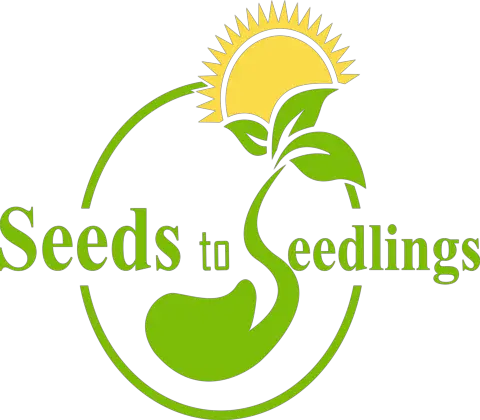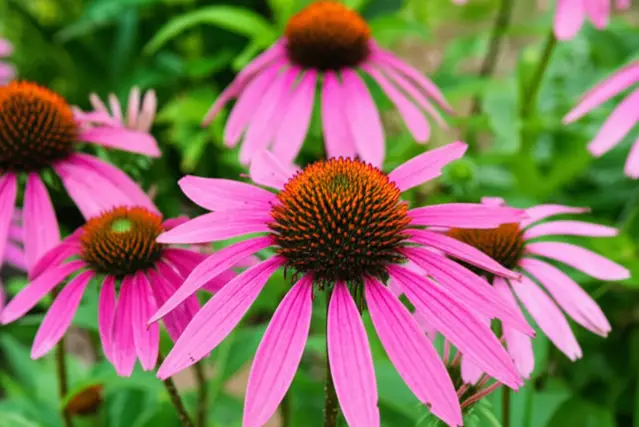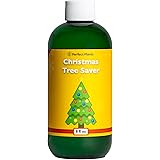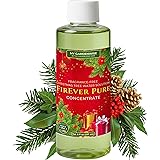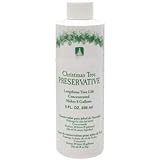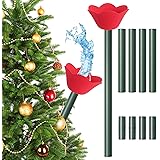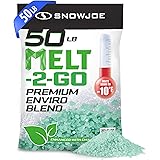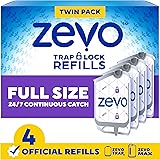Echinacea, also known as coneflower, is a beloved perennial in many gardens, prized for its daisy-like flowers and its ability to attract pollinators. But as the vibrant colors of summer fade and the cold of winter approaches, it’s crucial to take steps to ensure your echinacea plants survive and thrive, returning with even more impressive blooms in the spring.
This comprehensive guide provides the most up-to-date information for 2024, covering everything you need to know about overwintering echinacea, from understanding its hardiness to implementing the best care practices.
Gardening trends in 2024 are increasingly focused on sustainable practices and resilient plants. Data shows a significant rise in interest in native plants and those that support local ecosystems, which perfectly aligns with echinacea’s benefits. Furthermore, there’s a growing emphasis on low-maintenance gardening, making proper overwintering techniques even more essential for long-term plant health and reduced workload. The global gardening market is expected to reach \$137.3 billion by 2028, indicating a continuous and robust interest in all things gardening, and specifically for perennials, where proper maintenance is key.
Understanding the specific needs of your echinacea variety and your local climate is the first step towards successful overwintering. This guide will walk you through the process, offering expert tips and practical advice to help your coneflowers flourish for years to come. We’ll also address common problems and provide solutions to ensure your plants are well-prepared for the challenges of winter. Let’s dive in!
Understanding Echinacea and Winter Hardiness
Before we delve into overwintering techniques, it’s essential to understand the basics of echinacea and its hardiness. This knowledge will help you tailor your winter care to the specific needs of your plants.
Echinacea Varieties and Their Hardiness Zones
Echinacea belongs to the Asteraceae family and encompasses several species, each with slightly different characteristics and hardiness. The most common species is Echinacea purpurea (purple coneflower), but there are other popular varieties like Echinacea paradoxa (yellow coneflower) and various hybrids.

echinacea winter care
Understanding USDA plant hardiness zones is crucial. These zones are based on average minimum winter temperatures and help determine which plants can survive in a particular region. Most echinacea varieties are hardy in zones 3-9, but it’s always best to check the specific hardiness of your particular cultivar. You can easily find this information on the plant tag, seed packet, or through online gardening resources. Current USDA hardiness zone maps are available online, and it’s worth checking them periodically, as climate change is causing shifts in these zones in some regions.
Here’s a table outlining the hardiness of some popular Echinacea varieties:
| Echinacea Variety | USDA Hardiness Zones | Notable Characteristics |
|---|---|---|
| Echinacea purpurea (Purple Coneflower) | 3-9 | Classic purple petals, easy to grow. |
| Echinacea paradoxa (Yellow Coneflower) | 3-8 | Unique yellow petals, prefers well-drained soil. |
| Echinacea angustifolia (Narrow-leaved Coneflower) | 3-9 | Drought-tolerant, smaller blooms than E. purpurea. |
| Echinacea tennesseensis (Tennessee Coneflower) | 4-8 | Endangered species, upright petals. |
| Echinacea ‘Pow Wow Wild Berry’ | 3-8 | Compact size, vibrant pink blooms. |
| Echinacea ‘Cheyenne Spirit’ | 4-9 | Mixed colors (red, orange, yellow), first-year flowering. |
How Echinacea Survives Winter
Echinacea is a perennial, meaning it lives for more than two years. During the winter, the above-ground parts of the plant (stems, leaves, and flowers) typically die back, while the roots remain alive underground. These roots store energy that will fuel new growth in the spring. The plant enters a state of dormancy to conserve energy and protect itself from freezing temperatures.
The survival of echinacea over winter depends on several factors, including:
- Hardiness Zone: Plants grown outside their recommended hardiness zone are less likely to survive.
- Soil Drainage: Poorly drained soil can lead to root rot, especially in cold, wet conditions.
- Mulching: Mulch provides insulation and helps regulate soil temperature.
- Plant Health: Healthy, established plants are better able to withstand winter stress.
- Snow Cover: Snow acts as a natural insulator, protecting plants from extreme cold.
Understanding these factors will help you create the ideal conditions for your echinacea to thrive through the winter and emerge stronger in the spring. Knowing your specific variety and its hardiness is the foundation for successful overwintering.
Preparing Echinacea for Winter: A Step-by-Step Guide
Proper preparation is key to ensuring your echinacea plants survive the winter and return with vibrant blooms in the spring. This section provides a step-by-step guide to preparing your echinacea for the cold months ahead.
Timing is Everything: When to Start Preparing
The best time to begin preparing your echinacea for winter is in the late fall, after the first frost but before the ground freezes solid. This timing allows the plant to naturally begin its dormancy process. In most regions, this typically falls between late October and early December, but it’s essential to monitor your local weather conditions.
Avoid preparing your plants too early, as this can disrupt their natural dormancy cycle. Waiting until after the first frost ensures that the plant has received the signal to begin shutting down its above-ground growth and focusing its energy on root survival.
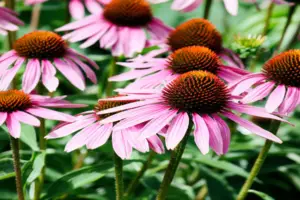
Pruning Echinacea: To Cut Back or Not to Cut Back?
The question of whether or not to prune echinacea in the fall is a matter of personal preference and garden aesthetics. There are valid arguments for both approaches:
- Pruning: Cutting back the stems to a few inches above the ground can tidy up the garden and prevent self-seeding. It also helps to reduce the risk of disease by removing dead or decaying foliage. Use clean, sharp pruning shears to avoid spreading any potential diseases.
- Leaving Seed Heads: Leaving the seed heads intact provides food for birds during the winter months and adds visual interest to the winter landscape. The dried seed heads can also self-sow, leading to new echinacea plants in the spring. If you choose to leave the seed heads, be sure to remove any diseased or damaged foliage.
A recent trend is to prune some plants and leave others, providing a balance between garden tidiness and wildlife support. For example, you might prune the echinacea in your formal garden beds while leaving those in a more naturalized area unpruned. Ultimately, the decision is yours, and both approaches can be successful.
Cleaning Up the Area: Removing Debris and Weeds
Before winter sets in, it’s crucial to clean up the area around your echinacea plants. Remove any fallen leaves, dead foliage, and weeds. This helps to prevent the spread of disease and pests that can overwinter in garden debris. Be sure to dispose of any diseased plant material properly, either by burning it or discarding it in a sealed bag (do not compost diseased plants).
Weeds can compete with your echinacea for nutrients and water, even during the winter months. Removing them now will give your plants a head start in the spring. Consider applying a layer of organic mulch to suppress weed growth and conserve soil moisture.
Mulching for Winter Protection: Choosing the Right Material
Mulching is one of the most important steps in overwintering echinacea. Mulch provides insulation, helping to regulate soil temperature and protect the roots from freezing and thawing cycles. It also helps to retain soil moisture and suppress weed growth.
Here are some excellent mulching options for echinacea:
- Straw: Straw is an excellent insulator and is readily available in many areas. Be sure to use straw, not hay, as hay contains seeds that can lead to weed problems.
- Shredded Bark: Shredded bark is a good choice for aesthetic appeal and provides long-lasting protection.
- Composted Leaves: Composted leaves are a great way to recycle fall leaves and provide nutrients to the soil. Make sure the leaves are well-composted to avoid matting down and suffocating the plants.
- Pine Needles: Pine needles are a good option for acidic soils and provide good drainage.
Avoid using heavy mulches like rocks or plastic sheeting, as these can trap moisture and lead to root rot. Aim for a mulch layer that is 2-4 inches thick, extending a few inches beyond the base of the plant. Be careful not to pile the mulch directly against the stems of the plant, as this can create a breeding ground for pests and diseases.
Watering Considerations: Hydration Before Dormancy
While echinacea is drought-tolerant, it’s important to ensure that the plants are adequately hydrated before winter sets in. Water deeply in late fall, before the ground freezes, to provide the roots with sufficient moisture to survive the winter. Avoid overwatering, as this can lead to root rot, especially in poorly drained soils. A good rule of thumb is to water when the top inch of soil feels dry to the touch.
During the winter months, only water if the soil becomes exceptionally dry. Echinacea requires very little water during dormancy, and overwatering is a more significant threat than underwatering. Check the soil moisture periodically, especially during periods of prolonged drought or extreme cold.
By following these steps, you can significantly increase the chances of your echinacea plants surviving the winter and returning with beautiful blooms in the spring. Remember to tailor your approach to your specific climate and echinacea variety for the best results. Consult with local gardening experts or your county extension office for more personalized advice.
Special Considerations for Different Climates and Situations
While the general overwintering guidelines apply to most regions, there are specific considerations for different climates and situations that can impact the success of your efforts. This section addresses these nuances to help you tailor your overwintering strategy to your specific circumstances.
Overwintering Echinacea in Cold Climates (Zones 3-5)
In colder climates, echinacea plants are more susceptible to damage from freezing temperatures and fluctuating freeze-thaw cycles. Extra precautions are needed to protect the roots from extreme cold.
- Extra Mulch: Apply a thicker layer of mulch (4-6 inches) to provide additional insulation. Consider using a combination of materials, such as straw and shredded bark, for optimal protection.
- Snow Cover: Encourage snow cover by leaving some taller stems intact or by strategically placing evergreen branches around the plants to trap snow. Snow acts as a natural insulator, protecting the plants from extreme cold.
- Wind Protection: Protect echinacea plants from harsh winter winds, which can desiccate the foliage and roots. Consider using burlap screens or evergreen boughs to create a windbreak.
- Container-Grown Plants: Container-grown echinacea is more vulnerable to freezing than plants in the ground. Move containers to a sheltered location, such as an unheated garage or shed, or bury them in the ground for added insulation. If you leave containers outdoors, wrap them in burlap or bubble wrap to protect the roots from freezing.
In very cold regions, some gardeners even create a temporary cold frame over their echinacea beds for added protection. A cold frame is a simple structure that provides a sheltered environment for plants, protecting them from wind, snow, and extreme cold.
Overwintering Echinacea in Mild Climates (Zones 8-9)
In milder climates, the primary concern is not freezing temperatures but rather excessive moisture and root rot. Well-drained soil is essential for overwintering echinacea in these regions.
- Excellent Drainage: Ensure that the soil is well-drained. Amend heavy clay soils with organic matter, such as compost or sand, to improve drainage.
- Light Mulch: Apply a light layer of mulch (1-2 inches) to retain moisture and suppress weeds, but avoid using heavy mulches that can trap moisture and promote root rot.
- Pruning: Prune back the stems to improve air circulation and reduce the risk of disease.
- Avoid Overwatering: Monitor soil moisture carefully and avoid overwatering. Echinacea plants require very little water during the winter months in mild climates.
In coastal areas, salt spray can also be a concern. Choose echinacea varieties that are more tolerant of salt spray, such as Echinacea angustifolia, and provide protection from direct exposure to salt-laden winds.
Overwintering Newly Planted Echinacea
Newly planted echinacea is more vulnerable to winter damage than established plants. Extra care is needed to ensure their survival.
- Plant Early: Plant echinacea in the early fall to allow the roots to establish before winter sets in.
- Extra Mulch: Apply a generous layer of mulch (3-4 inches) to protect the roots from freezing.
- Water Regularly: Water regularly during the fall to ensure that the roots are adequately hydrated.
- Protection from Wind and Sun: Provide protection from harsh winter winds and direct sun exposure. Consider using burlap screens or evergreen boughs to create a sheltered environment.
Some gardeners even choose to dig up newly planted echinacea and pot them up for the winter, keeping them in a sheltered location until spring. This allows the plants to develop a stronger root system before being exposed to the rigors of winter.
Overwintering Echinacea in Containers
Container-grown echinacea is more susceptible to temperature fluctuations and freezing than plants in the ground. Extra care is needed to protect the roots.
- Choose the Right Container: Select a container that is large enough to accommodate the plant’s root system and has good drainage.
- Use Well-Drained Soil: Use a well-drained potting mix to prevent root rot.
- Move to a Sheltered Location: Move the container to a sheltered location, such as an unheated garage or shed, to protect the roots from freezing.
- Insulate the Container: Wrap the container in burlap or bubble wrap to provide additional insulation.
- Water Sparingly: Water sparingly during the winter months, only when the soil becomes dry to the touch.
If you cannot move the container to a sheltered location, consider burying it in the ground for added insulation. Alternatively, you can group several containers together in a sheltered spot and cover them with mulch or straw.
Dealing with Pests and Diseases During Winter
While most pests and diseases are less active during the winter months, some can still pose a threat to your echinacea plants. It’s important to take preventative measures to minimize the risk of problems.
- Remove Diseased Foliage: Remove any diseased foliage from around the plants to prevent the spread of disease.
- Monitor for Pests: Check the plants periodically for signs of pests, such as aphids or spider mites. Treat any infestations promptly with insecticidal soap or horticultural oil.
- Ensure Good Air Circulation: Ensure good air circulation around the plants to prevent fungal diseases.
- Avoid Overwatering: Avoid overwatering, as this can create a favorable environment for fungal diseases.
Rodents, such as voles and mice, can also damage echinacea roots during the winter months. Protect your plants by placing wire mesh cages around the base of the plants or by using rodenticides (use with caution and follow label instructions carefully).
By taking these special considerations into account, you can tailor your overwintering strategy to your specific climate and situation, maximizing the chances of your echinacea plants surviving the winter and returning with beautiful blooms in the spring. Remember to observe your plants regularly and adjust your care as needed.
Signs of Trouble and Troubleshooting
Even with the best preparation, problems can sometimes arise during the winter months. Knowing how to identify signs of trouble and take corrective action can save your echinacea plants.
Identifying Common Winter Problems
Here are some common problems that can affect echinacea during the winter and how to identify them:
- Root Rot: Root rot is caused by excessive moisture and poor drainage. Symptoms include wilting, yellowing leaves, and a foul odor coming from the soil.
- Frost Heave: Frost heave occurs when the soil freezes and thaws repeatedly, pushing plants out of the ground. Symptoms include plants that are partially or completely dislodged from the soil.
- Desiccation: Desiccation is caused by dry winter winds that can dehydrate the foliage and roots. Symptoms include browning leaves and stems.
- Rodent Damage: Rodents, such as voles and mice, can damage echinacea roots during the winter months. Symptoms include chewed roots and stems.
- Disease: Although less common in winter, fungal diseases can still occur, especially in mild, damp climates. Symptoms include leaf spots, mold, and stem lesions.
Regularly inspecting your echinacea plants throughout the winter can help you catch problems early and take corrective action before they become severe. Pay particular attention to the base of the plants and the surrounding soil.
Troubleshooting Solutions for Winter Issues
Here are some solutions for addressing the common winter problems described above:
- Root Rot: Improve drainage by amending the soil with organic matter or sand. Avoid overwatering. If the problem is severe, you may need to dig up the plant, remove the rotted roots, and replant it in a new location with better drainage.
- Frost Heave: Gently push the plant back into the ground and apply a thick layer of mulch to insulate the soil and prevent further heaving. Consider moving the plant to a more sheltered location or a container.
- Desiccation: Protect the plants from wind by using burlap screens or evergreen boughs. Water the plants deeply during periods of prolonged drought. Apply an anti-desiccant spray to the foliage to help reduce water loss.
- Rodent Damage: Protect the plants by placing wire mesh cages around the base of the plants or by using rodenticides (use with caution and follow label instructions carefully). Remove any mulch or debris that may provide shelter for rodents.
- Disease: Remove any diseased foliage promptly. Ensure good air circulation around the plants. Apply a fungicide if necessary.
Prevention is always the best approach, so take steps to minimize the risk of these problems in the first place. Proper soil preparation, mulching, and watering practices can go a long way in protecting your echinacea plants from winter damage.
When to Seek Professional Help
In some cases, the problems affecting your echinacea plants may be too severe to handle on your own. Don’t hesitate to seek professional help from a certified arborist or horticulturalist if you are unsure how to proceed.
Here are some situations where professional help may be necessary:
- Extensive root rot that has killed a significant portion of the root system.
- Severe pest infestations that are difficult to control.
- Unidentified diseases that are causing significant damage to the plants.
- Concerns about soil contamination or drainage problems.
A professional can assess the situation, diagnose the problem, and recommend the best course of action to save your echinacea plants. They can also provide valuable advice on how to prevent future problems.
By being vigilant and proactive, you can address winter problems promptly and protect your echinacea plants from significant damage. Remember to monitor your plants regularly and don’t hesitate to seek help when needed. Local gardening clubs and county extension offices are also great resources for information and advice.
Spring Awakening: Preparing for New Growth
As winter loosens its grip and the first signs of spring appear, it’s time to start preparing your echinacea plants for new growth. This section outlines the steps you should take to help your plants emerge from dormancy and thrive in the coming season.
When to Remove Winter Protection
The timing of removing winter protection is crucial. Remove mulch too early, and the plants may be exposed to damaging late frosts. Remove it too late, and the plants may be stifled and delayed in their growth.
Here are some guidelines for determining when to remove winter protection:
- Monitor the Weather: Watch the weather forecast closely. Remove mulch and other protection after the last expected frost.
- Check the Soil Temperature: The soil temperature should be consistently above 40°F (4°C) before removing mulch.
- Observe Plant Growth: Look for signs of new growth emerging from the base of the plants. This is a good indication that it’s time to remove the mulch.
In general, it’s better to err on the side of caution and remove winter protection slightly later rather than too early. If you’re unsure, you can always remove some of the mulch gradually over a period of several days.
Spring Pruning and Clean-Up
Once the winter protection has been removed, it’s time to give your echinacea plants a spring pruning and clean-up.
- Remove Dead Foliage: Remove any dead or damaged foliage from the plants.
- Cut Back Stems: Cut back any remaining stems to the base of the plant.
- Clean Up Debris: Clean up any debris around the plants, such as fallen leaves or twigs.
- Loosen the Soil: Gently loosen the soil around the plants to improve air circulation and drainage.
Use clean, sharp pruning shears to avoid spreading any potential diseases. Dispose of any diseased plant material properly, either by burning it or discarding it in a sealed bag (do not compost diseased plants).
Fertilizing for a Strong Start
Fertilizing your echinacea plants in the spring can help them get off to a strong start and produce abundant blooms.
- Choose the Right Fertilizer: Use a balanced fertilizer with an N-P-K ratio of 10-10-10 or 5-10-5. Alternatively, you can use a slow-release fertilizer specifically formulated for perennials.
- Apply Fertilizer Correctly: Follow the instructions on the fertilizer label carefully. Avoid over-fertilizing, as this can lead to excessive foliage growth at the expense of blooms.
- Water After Fertilizing: Water the plants thoroughly after applying fertilizer to help the nutrients reach the roots.
Avoid using high-nitrogen fertilizers, as these can promote lush foliage growth but inhibit flowering. Organic fertilizers, such as compost or well-rotted manure, are also excellent choices for providing nutrients to your echinacea plants.
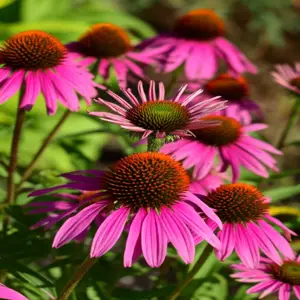
coneflower dormancy
Watering and Soil Care
Proper watering and soil care are essential for healthy echinacea growth in the spring.
- Water Regularly: Water the plants regularly, especially during dry periods. Allow the soil to dry out slightly between waterings to prevent root rot.
- Mulch: Reapply a layer of mulch around the plants to retain moisture, suppress weeds, and regulate soil temperature.
- Monitor Soil pH: Echinacea prefers a slightly acidic to neutral soil pH (6.0-7.0). Test the soil pH and amend it if necessary.
Consider adding compost or other organic matter to the soil to improve its fertility and drainage. Regular soil testing can help you identify any nutrient deficiencies or pH imbalances.
Pest and Disease Prevention in Spring
Spring is a time when pests and diseases become more active. Take preventative measures to protect your echinacea plants.
- Inspect Plants Regularly: Inspect the plants regularly for signs of pests or diseases.
- Remove Infested Foliage: Remove any infested or diseased foliage promptly.
- Apply Preventative Treatments: Apply preventative treatments, such as insecticidal soap or horticultural oil, if necessary.
- Ensure Good Air Circulation: Ensure good air circulation around the plants to prevent fungal diseases.
By taking these steps in the spring, you can help your echinacea plants emerge from dormancy and thrive throughout the growing season. Regular monitoring and proactive care are key to keeping your plants healthy and productive.
Echinacea Beyond the Garden: Medicinal and Culinary Uses
While echinacea is widely appreciated for its ornamental value, it also boasts a rich history of medicinal and culinary uses. Understanding these benefits can add another layer of appreciation for this versatile plant.
Medicinal Properties and Traditional Uses
Echinacea has been used for centuries by Native American tribes for its medicinal properties. It is believed to boost the immune system, fight infections, and reduce inflammation. Modern research has explored these traditional uses, with some studies suggesting that echinacea may help shorten the duration of colds and flu.
The primary active compounds in echinacea are thought to be alkylamides, polysaccharides, and caffeic acid derivatives. These compounds are believed to interact with the body’s immune system to enhance its response to infections.
Here are some of the traditional and modern medicinal uses of echinacea:
- Boosting the Immune System: Echinacea is often used to prevent or treat colds, flu, and other respiratory infections.
- Wound Healing: Echinacea has been used topically to promote wound healing and reduce inflammation.
- Skin Conditions: Echinacea may be used to treat skin conditions such as eczema and psoriasis.
- Pain Relief: Echinacea has been used to relieve pain associated with infections, inflammation, and injuries.
It’s important to note that while echinacea is generally considered safe, it can interact with certain medications and may not be suitable for everyone. Consult with a healthcare professional before using echinacea for medicinal purposes, especially if you have any underlying health conditions or are taking other medications.
Harvesting and Preparing Echinacea for Medicinal Use
If you’re interested in harvesting and preparing echinacea for medicinal use, here are some guidelines:
- Harvest Time: The best time to harvest echinacea for medicinal purposes is in the fall, after the flowers have finished blooming.
- Parts to Harvest: The roots, leaves, and flowers can all be used for medicinal purposes. The roots are generally considered to have the highest concentration of active compounds.
- Drying: Dry the harvested plant parts in a cool, dark, and well-ventilated place. Spread the plant parts out on a screen or tray and turn them regularly to ensure even drying.
- Storage: Store the dried plant parts in an airtight container in a cool, dark, and dry place.
Once you have dried echinacea, you can use it to make teas, tinctures, and salves. There are many recipes available online and in herbal medicine books. Always use caution and follow reputable recipes when preparing herbal remedies.
Culinary Uses and Recipes
While not as widely known, echinacea also has some culinary uses. The leaves and flowers can be added to salads, soups, and teas for a unique flavor and potential health benefits. The roots can also be cooked and eaten as a vegetable.
Here are some culinary uses of echinacea:
- Echinacea Tea: Steep dried echinacea leaves and flowers in hot water for 10-15 minutes to make a soothing tea.
- Echinacea Salad: Add fresh echinacea leaves and flowers to salads for a slightly peppery flavor.
- Echinacea Soup: Add chopped echinacea roots to soups and stews for added flavor and nutrients.
- Echinacea Infused Honey: Infuse honey with echinacea flowers for a unique and flavorful sweetener.
When using echinacea in cooking, start with small amounts and taste as you go. The flavor can be quite strong, so it’s best to use it sparingly. As with medicinal uses, be mindful of potential allergies or sensitivities when consuming echinacea.
Ethical and Sustainable Harvesting
If you plan to harvest echinacea for medicinal or culinary use, it’s important to do so ethically and sustainably. Overharvesting can deplete wild populations of echinacea, especially rare or endangered species.
Here are some tips for ethical and sustainable harvesting:
- Harvest Sparingly: Only harvest what you need and leave plenty of plants to reproduce.
- Harvest Selectively: Avoid harvesting all of the plants in one area. Leave some plants to mature and spread their seeds.
- Propagate Your Own: Consider propagating your own echinacea plants from seed or cuttings to reduce the pressure on wild populations.
- Support Sustainable Growers: Purchase echinacea products from reputable growers who use sustainable harvesting practices.
By being mindful of the environment and practicing sustainable harvesting techniques, you can help ensure that echinacea continues to thrive for generations to come. Respecting the plant and its natural habitat is crucial for its long-term survival.
From its beautiful blooms to its medicinal and culinary uses, echinacea is a truly versatile and valuable plant. By understanding its various benefits and using it responsibly, you can appreciate its many gifts and help ensure its continued availability for future generations.
The Future of Echinacea: Research, Trends, and Conservation
Echinacea continues to be a subject of interest in both scientific research and horticultural trends. Understanding the current landscape and future directions can help you appreciate the ongoing evolution of this remarkable plant.
Current Research and Scientific Studies
Scientific research on echinacea is ongoing, with studies focusing on its medicinal properties, genetic diversity, and conservation. Researchers are exploring the potential of echinacea to treat a variety of conditions, including infections, inflammation, and cancer.
Here are some of the current research areas:
- Immune System Modulation: Studies are investigating the mechanisms by which echinacea interacts with the immune system and its potential to enhance immune function.
- Antiviral Activity: Researchers are exploring the antiviral properties of echinacea and its potential to treat viral infections.
- Anti-inflammatory Effects: Studies are examining the anti-inflammatory effects of echinacea and its potential to treat inflammatory conditions.
- Cancer Research: Some studies are investigating the potential of echinacea to inhibit cancer cell growth and metastasis.
- Genetic Diversity and Conservation: Researchers are studying the genetic diversity of echinacea populations to inform conservation efforts and ensure the long-term survival of the species.
While many studies have shown promising results, more research is needed to fully understand the effects of echinacea and to determine its optimal uses. It’s important to stay informed about the latest research and to consult with a healthcare professional before using echinacea for medicinal purposes.
Emerging Trends in Echinacea Cultivation and Breeding
Echinacea breeding and cultivation are constantly evolving, with new varieties and techniques emerging all the time. Here are some of the current trends:
- New Flower Colors and Forms: Breeders are developing new echinacea varieties with a wider range of flower colors, including oranges, yellows, reds, and even greens. They are also creating varieties with different flower forms, such as double blooms and crested forms.
- Compact and Dwarf Varieties: Compact and dwarf varieties of echinacea are becoming increasingly popular for small gardens and containers.
- Disease Resistance: Breeders are focusing on developing varieties that are more resistant to common echinacea diseases, such as powdery mildew and aster yellows.
- Longer Blooming Periods: Breeders are working to extend the blooming period of echinacea, so gardeners can enjoy their flowers for a longer period of time.
- Native Plant Emphasis: There’s an increasing interest in cultivating native echinacea species and promoting their use in landscaping. This aligns with broader trends towards native plant gardening and supporting local ecosystems.
These trends reflect a growing interest in echinacea as a versatile and adaptable plant that can thrive in a variety of garden settings. Look for these new varieties and improved cultivars at your local garden centers and nurseries.
Conservation Efforts and Protecting Wild Populations
Some echinacea species are threatened or endangered due to habitat loss, overharvesting, and other factors. Conservation efforts are crucial to protecting these wild populations and ensuring their long-term survival.
Here are some of the conservation efforts underway:
- Habitat Protection: Protecting and restoring echinacea habitats is essential for conserving wild populations. This includes preserving prairies, grasslands, and other natural areas where echinacea grows.
- Seed Banking: Seed banking involves collecting and storing seeds from wild echinacea populations to preserve their genetic diversity.
- Reintroduction Programs: Reintroduction programs involve planting echinacea plants in areas where they have been lost due to habitat destruction.
- Choosing Native Varieties: Opt for native echinacea species (like Echinacea purpurea or Echinacea angustifolia) over hybrids, as they support local pollinators and ecosystems.
- Avoiding Wild Harvesting: Purchase seeds or plants from reputable nurseries that practice ethical propagation rather than collecting from the wild.
- Participating in Citizen Science: Some organizations track echinacea populations—consider contributing data if you spot wild coneflowers.
- Supporting Conservation Organizations: Donate to or volunteer with groups like the Native Plant Trust or The Xerces Society, which work to protect native plants and pollinators.
Echinacea in Sustainable Landscaping
With growing interest in eco-friendly gardening, echinacea is a star player in sustainable landscapes because:
- Drought Tolerance: Once established, it requires minimal watering, making it ideal for xeriscaping.
- Pollinator Magnet: Bees, butterflies, and birds rely on echinacea for nectar and seeds.
- Low Maintenance: Its hardiness reduces the need for chemical fertilizers or pesticides.
Trend Alert (2025): More gardeners are integrating echinacea into prairie-style gardens, rain gardens, and wildlife-friendly yards as part of a broader movement toward biodiversity-focused landscaping.
FAQs About Overwintering Echinacea
Q: Can echinacea survive frost?
A: Yes! Established plants tolerate frost, but young or potted ones may need extra protection.
Q: Should I water echinacea in winter?
A: Only if the soil is very dry; overwatering in cold weather is risky.
Q: Why didn’t my echinacea come back after winter?
A: Possible causes: poor drainage, extreme cold without mulch, or disease. Try amending soil or relocating the plant.
Q: Can I grow echinacea in pots year-round?
A: In cold climates, move pots to a sheltered spot (like a garage) to prevent root freezing.
Q: Does echinacea spread on its own?
A: Some varieties self-seed; deadhead flowers if you want to control spread.
Final Thoughts: Ensuring Your Echinacea Thrives Year After Year
Overwintering echinacea successfully hinges on understanding your local climate, providing proper insulation (mulch!), and adjusting care for young or container-grown plants. By following this guide, you’ll not only help your coneflowers survive winter but also encourage vigorous spring growth and blooms.
Key Takeaways:
- Know Your Zone: Match echinacea varieties to your USDA hardiness zone.
- Mulch Wisely: 2–4 inches of straw or shredded leaves protect roots from freeze-thaw cycles.
- Prune (or Don’t): Leave seed heads for wildlife or cut back for tidiness—both work!
- Monitor Moisture: Avoid soggy soil, which leads to root rot.
- Spring Prep: Remove mulch gradually, fertilize lightly, and watch for pests.
Whether you grow echinacea for its beauty, pollinators, or herbal benefits, this resilient perennial will reward your care with years of vibrant color and ecological value.
Auto Amazon Links: No products found.
Perfect Plants Christmas Tree Saver 8oz. | Easy Use Xmas Tree Preserver Food | Have Healthy Green Christmas Trees All Holiday Season
$9.97 (as of December 15, 2025 05:17 GMT +00:00 - More info- Product prices and availability are accurate as of the date/time indicated and are subject to change. Any price and availability information displayed on [relevant Amazon Site(s), as applicable] at the time of purchase will apply to the purchase of this product.
FirEver Pure Christmas Tree Food | Preserver Additive & Season Extender for Live Xmas Trees | Keep It Green, Reduce Needle-Drop | Miracle Freshness (8 oz)
$14.99 (as of December 15, 2025 05:17 GMT +00:00 - More info- Product prices and availability are accurate as of the date/time indicated and are subject to change. Any price and availability information displayed on [relevant Amazon Site(s), as applicable] at the time of purchase will apply to the purchase of this product.
Rocky Mountain Goods Christmas Tree Food - 8 oz Tree Preservative - Reduce Needle Drop - Greener Scent - Fir, Pine, Spruce Trees - Extend Tree Life
$9.95 (as of December 15, 2025 05:17 GMT +00:00 - More info- Product prices and availability are accurate as of the date/time indicated and are subject to change. Any price and availability information displayed on [relevant Amazon Site(s), as applicable] at the time of purchase will apply to the purchase of this product.
VICAMB 39.3 Inch Christmas Tree Watering Funnel,Christmas Tree Watering System Device,Long Tree Watering Funnel Spout for Indoor Outdoor Xmas Tree
$17.99 (as of December 15, 2025 05:17 GMT +00:00 - More info- Product prices and availability are accurate as of the date/time indicated and are subject to change. Any price and availability information displayed on [relevant Amazon Site(s), as applicable] at the time of purchase will apply to the purchase of this product.
EZMeetU Christmas Tree Watering Funnel, 47 Inch Flower Shape Adjustable 6 Section Design, Christmas Tree Watering System, Christmas Tree Waterer, Long Funnel Wide Opening Reusable, Plant Watering Tool
$16.99 (as of December 15, 2025 05:17 GMT +00:00 - More info- Product prices and availability are accurate as of the date/time indicated and are subject to change. Any price and availability information displayed on [relevant Amazon Site(s), as applicable] at the time of purchase will apply to the purchase of this product.
Snow Joe Premium Enviro Blend Ice Melt, Green-Coated Deicer Crystals, 50 lb - Safer Melter for Vegetation, Concrete & Metals w/ Anti-Corrosion Calcium Magnesium Acetate
$32.97 (as of December 12, 2025 19:27 GMT +00:00 - More info- Product prices and availability are accurate as of the date/time indicated and are subject to change. Any price and availability information displayed on [relevant Amazon Site(s), as applicable] at the time of purchase will apply to the purchase of this product.
Muddy Mat® Shown on TV Super Absorbent Microfiber Dog Door Mat for Muddy Paws, Non-Slip Washable Pet Rug, Quick Dry Chenille Entryway Carpet, Machine Washable Indoor Outdoor mat, Grey 30"x19"
$24.95 (as of December 12, 2025 19:27 GMT +00:00 - More info- Product prices and availability are accurate as of the date/time indicated and are subject to change. Any price and availability information displayed on [relevant Amazon Site(s), as applicable] at the time of purchase will apply to the purchase of this product.
ivtivfu Rolling Grill Basket, Removable Wooden Handle, 304 Stainless Steel, Nesting BBQ Tools, Smoker Grilling Accessories for Vegetable, Outdoor Cooking Camping, Birthday Gifts for Men Dad Husband
$25.99 (as of December 12, 2025 19:27 GMT +00:00 - More info- Product prices and availability are accurate as of the date/time indicated and are subject to change. Any price and availability information displayed on [relevant Amazon Site(s), as applicable] at the time of purchase will apply to the purchase of this product.
XXXFLOWER Plant Terrarium with Wooden Stand, Air Planter Bulb Glass Vase Metal Swivel Holder Retro Tabletop for Hydroponics Home Garden Office Decoration - 3 Bulb Vase
$18.98 (as of December 12, 2025 19:27 GMT +00:00 - More info- Product prices and availability are accurate as of the date/time indicated and are subject to change. Any price and availability information displayed on [relevant Amazon Site(s), as applicable] at the time of purchase will apply to the purchase of this product.
Zevo Flying Insect Trap Official Refill Cartridges - Fits Both Zevo Trap & MAX Indoor Fly Trap - Authentic Trap+Lock Technology to Catch Gnats, House & Fruit Flys (4 Official Refill Cartridges)
$14.97 (as of December 12, 2025 19:27 GMT +00:00 - More info- Product prices and availability are accurate as of the date/time indicated and are subject to change. Any price and availability information displayed on [relevant Amazon Site(s), as applicable] at the time of purchase will apply to the purchase of this product.
